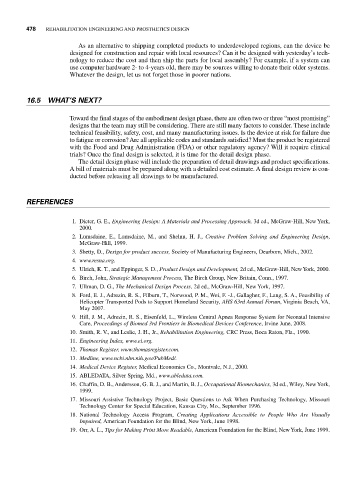Page 500 - Biomedical Engineering and Design Handbook Volume 2, Applications
P. 500
478 REHABILITATION ENGINEERING AND PROSTHETICS DESIGN
As an alternative to shipping completed products to underdeveloped regions, can the device be
designed for construction and repair with local resources? Can it be designed with yesterday’s tech-
nology to reduce the cost and then ship the parts for local assembly? For example, if a system can
use computer hardware 2- to 4-years old, there may be sources willing to donate their older systems.
Whatever the design, let us not forget those in poorer nations.
16.5 WHAT’S NEXT?
Toward the final stages of the embodiment design phase, there are often two or three “most promising”
designs that the team may still be considering. There are still many factors to consider. These include
technical feasibility, safety, cost, and many manufacturing issues. Is the device at risk for failure due
to fatigue or corrosion? Are all applicable codes and standards satisfied? Must the product be registered
with the Food and Drug Administration (FDA) or other regulatory agency? Will it require clinical
trials? Once the final design is selected, it is time for the detail design phase.
The detail design phase will include the preparation of detail drawings and product specifications.
A bill of materials must be prepared along with a detailed cost estimate. A final design review is con-
ducted before releasing all drawings to be manufactured.
REFERENCES
1. Dieter, G. E., Engineering Design: A Materials and Processing Approach, 3d ed., McGraw-Hill, New York,
2000.
2. Lumsdaine, E., Lumsdaine, M., and Shelnu, H. J., Creative Problem Solving and Engineering Design,
McGraw-Hill, 1999.
3. Shetty, D., Design for product success, Society of Manufacturing Engineers, Dearborn, Mich., 2002.
4. www.resna.org.
5. Ulrich, K. T., and Eppinger, S. D., Product Design and Development, 2d ed., McGraw-Hill, New York, 2000.
6. Birch, John, Strategic Management Process, The Birch Group, New Britain, Conn., 1997.
7. Ullman, D. G., The Mechanical Design Process, 2d ed., McGraw-Hill, New York, 1997.
8. Ford, E. J., Adrezin, R. S., Filburn, T., Norwood, P. M., Wei, F. -J., Gallagher, F., Lang, S. A., Feasibility of
Helicopter Transported Pods to Support Homeland Security, AHS 63rd Annual Forum, Virginia Beach, VA,
May 2007.
9. Hill, J. M., Adrezin, R. S., Eisenfeld, L., Wireless Central Apnea Response System for Neonatal Intensive
Care, Proceedings of Biomed 3rd Frontiers in Biomedical Devices Conference, Irvine June, 2008.
10. Smith, R. V., and Leslie, J. H., Jr., Rehabilitation Engineering, CRC Press, Boca Raton, Fla., 1990.
11. Engineering Index, www.ei.org.
12. Thomas Register, www.thomasregister.com.
13. Medline, www.ncbi.nlm.nih.gov/PubMed/.
14. Medical Device Register, Medical Economics Co., Montvale, N.J., 2000.
15. ABLEDATA, Silver Spring, Md., www.abledata.com.
16. Chaffin, D. B., Andersson, G. B. J., and Martin, B. J., Occupational Biomechanics, 3d ed., Wiley, New York,
1999.
17. Missouri Assistive Technology Project, Basic Questions to Ask When Purchasing Technology, Missouri
Technology Center for Special Education, Kansas City, Mo., September 1996.
18. National Technology Access Program, Creating Applications Accessible to People Who Are Visually
Impaired, American Foundation for the Blind, New York, June 1998.
19. Orr, A. L., Tips for Making Print More Readable, American Foundation for the Blind, New York, June 1999.

